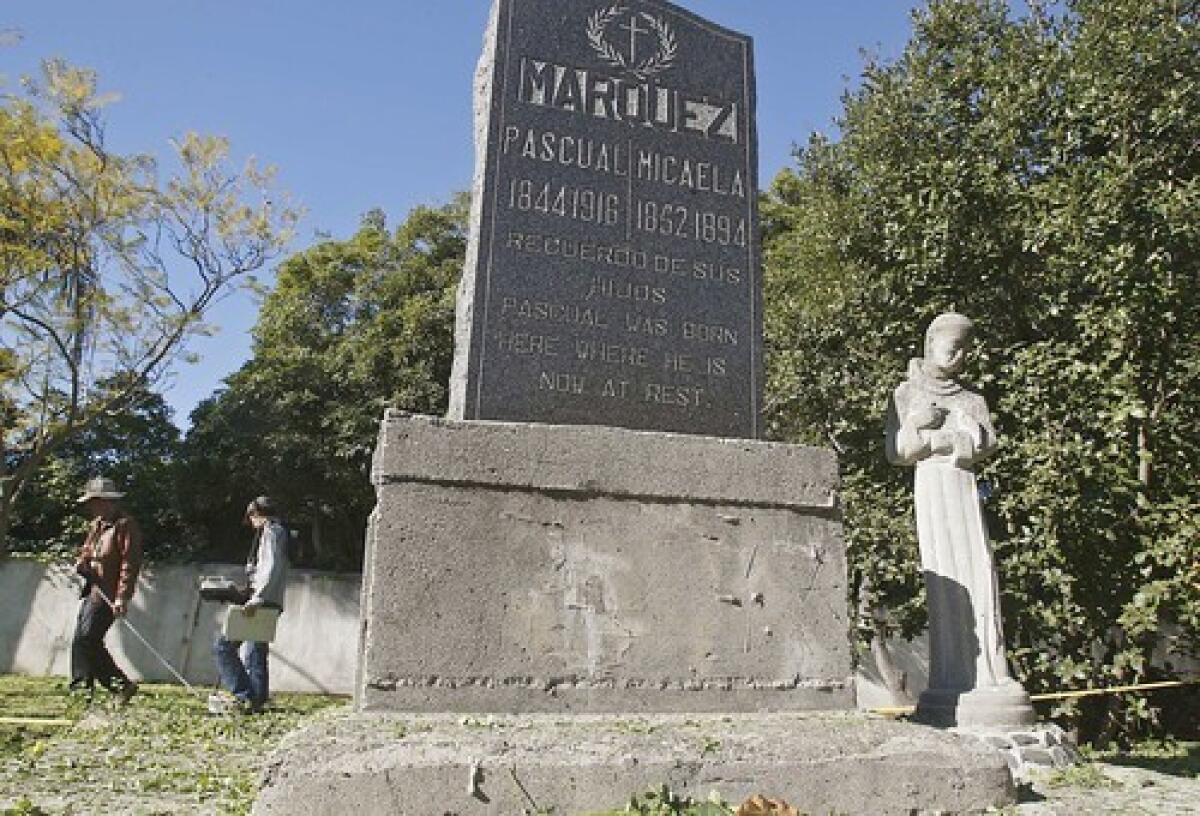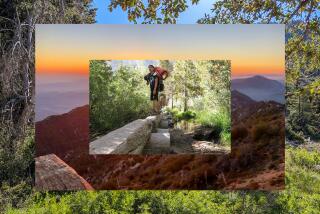Marquez descendant hopes to restore family cemetery in Santa Monica Canyon

- Share via
Long before Santa Monica Canyon became prime real estate for successful Angelenos, it served as a serene resting place for some of the area’s early and prominent landowners.
In the late 1840s, Francisco Marquez, the Mexican co-holder of the Rancho Boca de Santa Monica land grant given by his government, established a burial ground on the canyon’s wide-open upper mesa. The cemetery contains the remains of Pascual, his youngest son, and perhaps 30 other family members, American Indian servants and friends -- including 13 guests who died of botulism after eating home-canned peaches at a New Year’s Eve gathering in 1909.
FOR THE RECORD:
Marquez cemetery: An article in Monday’s California section about the Marquez Family Cemetery in Santa Monica Canyon said the cemetery, owned by Ernest Marquez, is the only portion of an original Mexican land grant that remains in the Marquez family’s hands. Rosemary Marquez Romero Miano, another descendant of Francisco Marquez, also owns a piece of property from the original land grant. —
Last week, the usually tranquil Marquez Family Cemetery -- which was deemed by the city of Los Angeles in 2000 an “extremely historic” landmark for representing the region’s ranch families -- buzzed with activity. Scientists armed with ground-penetrating radar imaging equipment traipsed back and forth to find precisely where the bodies are buried. The equipment enables scientists to “see” below ground without disturbing the site.
They were joined by students from UCLA’s Cotsen Institute of Archaeology, who took part in a workshop. Come Jan. 31, specially trained dogs from the Institute for Canine Forensics, a Northern California nonprofit group, will put their noses to the ground to see whether they can sniff out any historic remains.
The aim is to learn the cemetery’s true boundaries and the burial locations so that preservationists, including Pascual’s grandson Ernest, can develop a restoration plan and eventually open it to the public. La Señora Research Institute de Rancho Boca de Santa Monica, a nonprofit group based in the canyon, is covering some of the costs. Foundations and neighbors are also contributing.
“I want to keep it in its natural state and not modernize it in any way,” said Ernest Marquez, 84, a local historian who grew up in Santa Monica Canyon and lives in the San Fernando Valley. “When you come here, you are transported back to rancho days. There’s an aura here that you don’t get anywhere else.”
Today the burial ground, overgrown with weeds and missing all but two of its grave markers, sits tucked away behind a rustic wooden fence on San Lorenzo Street. Few people know it’s there.
With its haphazard handful of citrus and other trees, the cemetery indeed seems to have been transplanted from a simpler time and place into a populated residential neighborhood. In fact, it’s the other way around. The canyon’s many houses -- some grand, some modest -- grew up around the burial ground.
As Ernest Marquez relates in his book “Santa Monica Beach,” the Mexican government in 1839 granted the area that eventually became portions of Santa Monica and Pacific Palisades to two Mexican citizens, Francisco Marquez and Ysidro Reyes.
The men began cattle ranching on their joint 6,656 acres, built adobe homes and started raising families. Because the nearest Catholic cemetery was a day’s trip away, Marquez set aside land for a burial ground within view of his adobe.
The ranchers routinely welcomed visitors from hot, dusty Los Angeles, who camped and enjoyed cool ocean breezes.
In 1879, Pascual Marquez married Reyes’ daughter Micaela (also spelled Michaela), uniting the families by marriage as well as property. The couple had 10 children, including Ernest’s father, Pascual Castulo Marquez. The elder Pascual Marquez, who died in 1916, was the last to be buried in the cemetery -- very near where he was born in the family’s adobe in 1844.
During the course of his grandfather’s life, Ernest Marquez said, Santa Monica Canyon evolved from wilderness country into a popular weekend resort.
In the mid-1920s, the families sold the land to Santa Monica Land & Water Co., owned by Robert Gillis. As the canyon was subdivided for houses, his daughter, Dorothy Gillis Loomis, urged him to protect the cemetery. She commissioned noted architect John Byers to design an adobe wall to surround the cemetery. According to local lore, Loomis brought from Mexico a wooden statue of San Lorenzo and placed it in a niche in the wall. The statue has recently been restored.
The arrangement created a problem of access because the cemetery was landlocked amid privately owned parcels. Marquez family members entered via a 4-foot-wide easement that runs from the center of the cemetery’s front wall to San Lorenzo Street.
The cemetery’s last owner of record, Pedro Marquez, died in 1952, and the property passed to various heirs, who recently signed the property over to Ernest Marquez.
Marquez also spent several years in court battling neighbors who contended that the easement had been terminated by nonuse. In 2005, a Los Angeles Superior Court judge decided in Marquez’s favor, allowing him to use the easement to enter and maintain the cemetery.
Now Marquez hopes that the heir of one of those neighbors will donate or sell the front property so that he and supporters can create a pocket park.
Although nothing is official, the owner’s attorney has hinted that she might be willing to sell. La Señora Research Institute could line up donors to buy the property, said Tish Nettleship, the institute’s founder.
The 3-D data gleaned from the recent surveys should help spark interest. So far, they reveal at least four possible areas of unmarked remains that should be tested, said Dean Goodman, a Woodland Hills geophysicist who is helping with the mapping.
“We also see something that looks like the original adobe foundation,” Goodman said one recent morning at the site. Goodman has previously surveyed ancient buried wall foundations in Vescovio, Italy; a buried garden pond at the villa of Roman emperor Trajan; Genghis Khan’s palace in eastern Mongolia; imperial family tombs in Osaka, Japan; and the Presidio in San Francisco.
Much remains to be done before the site can be restored. But supporters envision grave markers, pathways and lovely landscaping.
The cemetery, one of the city’s oldest burial grounds, is the only portion of the original Mexican land grant that remains in the Marquez family’s hands.
That makes it imperative that it be preserved, Nettleship said.
“We’ve lost track of our history,” she said. “We need to make the next generation aware of the value of knowing the history of those who came before us.”
More to Read
Sign up for Essential California
The most important California stories and recommendations in your inbox every morning.
You may occasionally receive promotional content from the Los Angeles Times.











